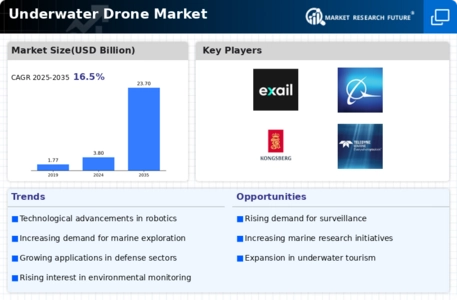Market Trends
Key Emerging Trends in the Underwater Drone Market
The oil & gas industry is set to grow steadily in the upcoming years, bouncing back from a global slowdown in 2014. Extracting oil & gas from both traditional and non-traditional sources is becoming more dynamic. To meet the demand for oil & gas in various industries, the use of robotics and automation in challenging offshore environments is increasing. ROVs (Remotely Operated Vehicles) are underwater robots connected to ships by a cable, carrying signals between the operator and the ROV. Equipped with cameras, manipulators, and water samplers, ROVs monitor maritime environments, light penetration, and water temperature.
ROVs play a crucial role in the oil & gas industry, assisting in activities ranging from drilling and construction support to well decommissioning. Their demand is growing in complex and explosive environments, underwater pipeline management, platforms, and other operations.
The graph below illustrates the rig count worldwide, showing an increase from 2016 to 2017. This suggests a positive impact on oil & gas production, driven by the rising demand. As oil & gas companies explore deep-water oilfields in challenging environments, the use of ROVs becomes essential. Additionally, personnel working in offshore rigs face challenges like limited space and evacuation issues during emergencies. ROVs, designed for specific tasks in deep-water oil & gas fields, address these challenges and contribute to meeting the growing global demand for oil & gas.
The increasing rig count, both globally and in the US, reflects rising investments in the oil & gas industry. This is expected to lead to a greater demand for ROVs to enhance operational efficiency. For example, in July 2018, M2 Subsea Ltd secured a contract to provide inspection services for Premier Oil's Balmoral floating production vessel (FPV). The inspection, conducted by M2 Subsea's Mohican ROV at a depth of 140 meters, covers the vessel's hull, flowlines, umbilicals, risers, and subsea template. The continuous growth in the oil & gas industry, as evidenced by the increasing rig count, indicates a sustained focus on exploration and production activities. The rising demand for oil & gas, especially in challenging deep-water environments, underscores the need for advanced technologies like ROVs. As exploration ventures into more complex and remote areas, ROVs play a pivotal role in ensuring efficient operations and overcoming the limitations of traditional methods. The recent contract secured by M2 Subsea Ltd for inspection services using ROVs further exemplifies the industry's reliance on these robotic solutions for maintaining infrastructure integrity in offshore settings.








Leave a Comment